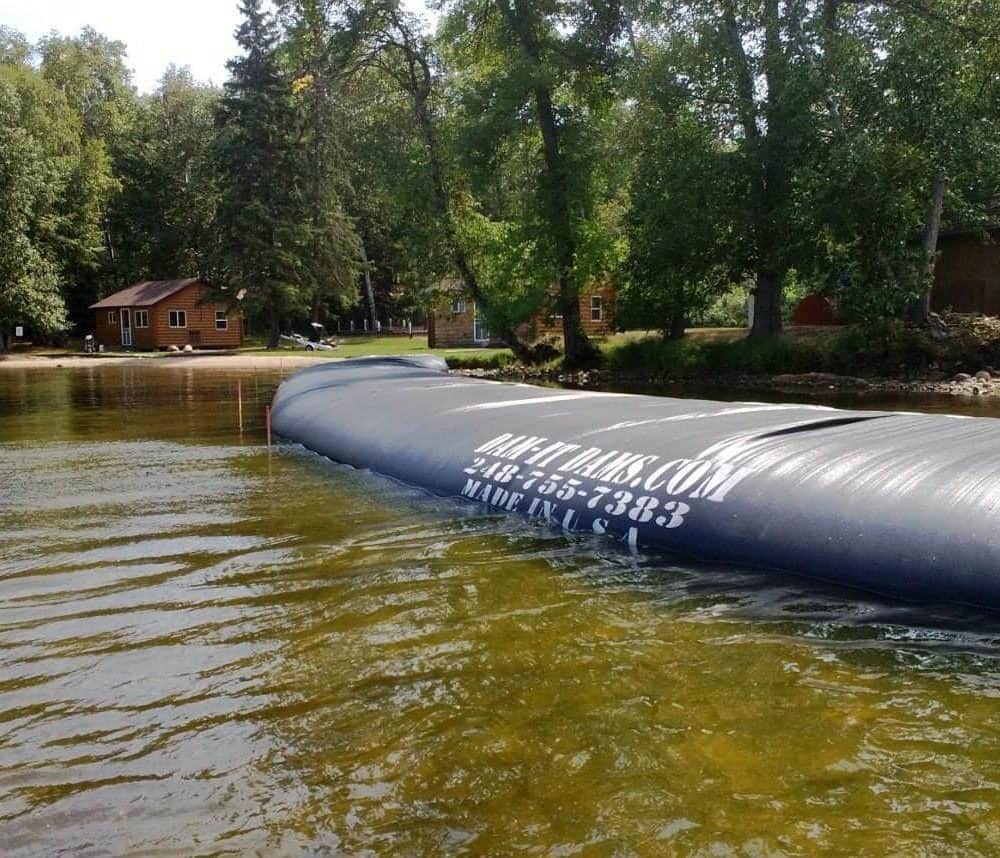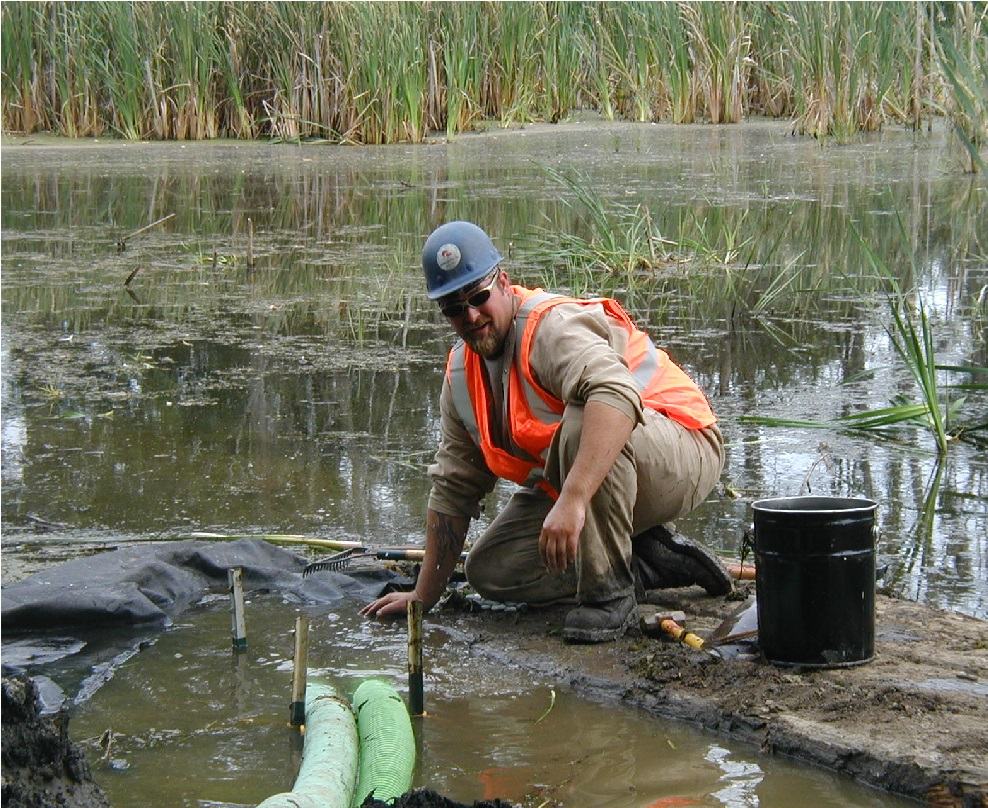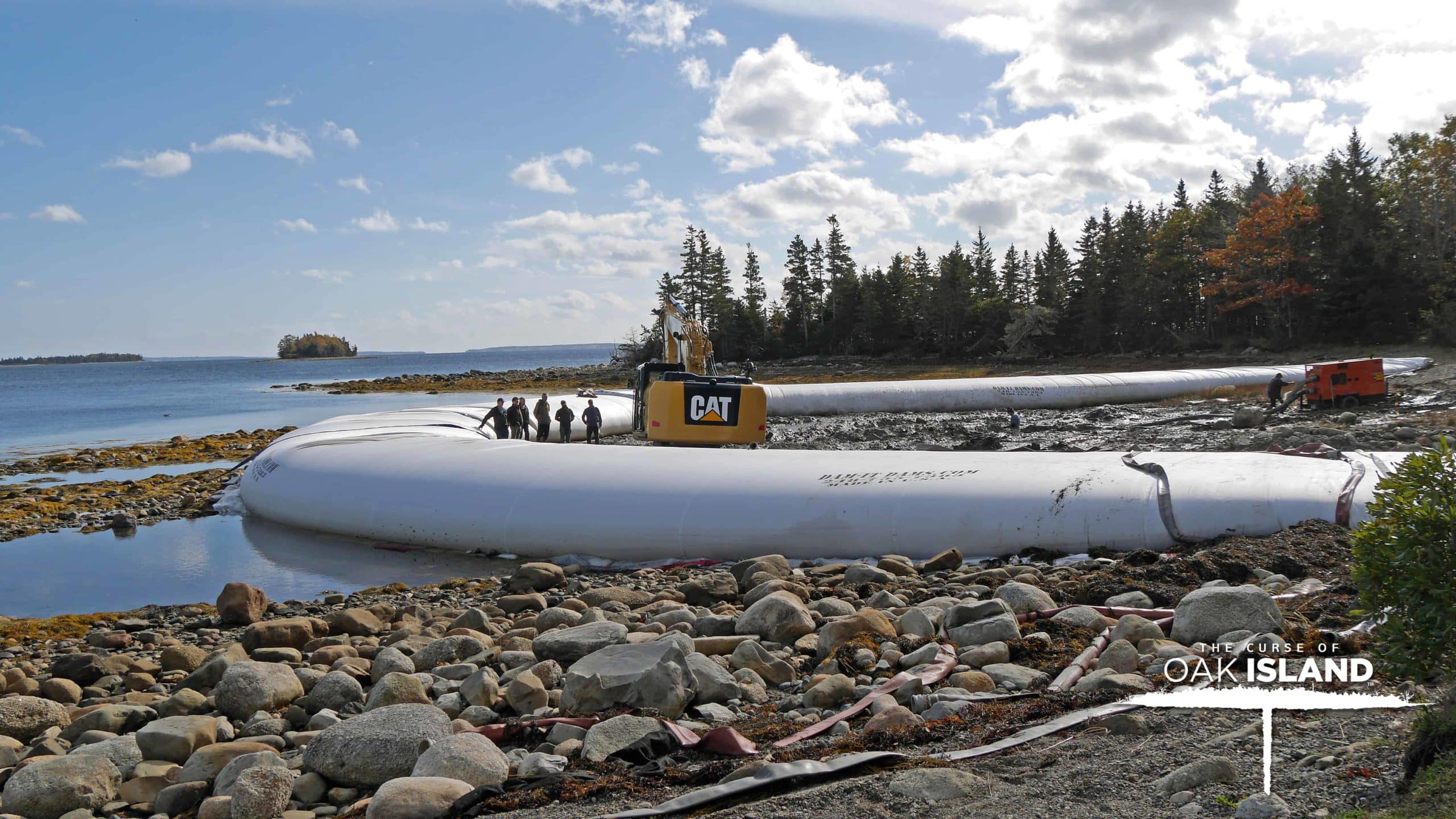Dam-It Dams Patented Cofferdam Construction Method: Basic Configurations
- Dam-It Dams portable cofferdams are made of a heavy-duty Geo-textile woven polypropylene outer casing that contains two side-by-side inner tubes. The inner dual tubes act as a stabilizer during cofferdam construction and use, to keep the cofferdam from rolling due to outside water pressure and other forces.
- Based on the depth of water you need to control, our cofferdams come in eight different heights: 1-2-3-4-6-8-10 and 12 feet.
- Important note: The cofferdam needs to be 25% higher (above board) than the depth of the water you are controlling. Example: 4 feet of water will require a 5′ high dam.
- Onsite water is pumped AT THE SAME RATE into the two fill tubes during construction.
- As the water enters both inner tube chambers, the cofferdam slowly and evenly inflates, creating a strong, stable cylindrical tube.
- As the inner tubes fill and the water pressure builds, the Cofferdam unrolls in a controlled manner to create a “barrier dam” so you are able to begin your water project.
- The cofferdam can be small or large and molds perfectly to the lake bed, riverbed or waterbed.
- Our cofferdams can be extended to any length necessary. Using the extension coupling system, individual dams are easily linked together during construction, to create a watertight chained barrier. Extremely durable once inflated, you will be able to walk on the cofferdam when adding extensions.
- The dam is flexible and easy to install, steer or turn precisely where you need it.
- When the cofferdam construction is complete, and the dam is properly placed and filled to specifications, you can begin your project by pumping water from the side that needs to be De-watered. After you have completed your water project, simply deflate the Cofferdam for convenient storage and future use.

COFFERDAM CONSTRUCTION PREPARATION
Construction Considerations:
Have you been in the water yet? It is imperative that you know the surface soil conditions at your site to ensure that you have the right size cofferdam. Due to the increased pressure of the cofferdam, surface soil settlement may affect the size of the dam you will require.
- Water depth: (You will need to know the deepest water-depth level)
- Soil composition (soft bottom, muck, etc.)
- Determine water movement: Still, standing or moving.

CHECK THE BOTTOM
You will need to make sure there are no surprises under the water surface that could hinder a successful deployment. Examples: Large boulders, metal poles, wood posts, rebar, glass, sunken tree limbs, old shopping carts, cars, Jimmy Hoffa … etc.
SIZE MATTERS:
Determine the height before you begin
– Our cofferdams come in eight heights: 1-2-3-4-6-8-10 and 12 feet.
– Small Cofferdams: 1-4 ft. in height
– Large Cofferdams: 6-12 ft. in height
– A custom designed Cofferdam can be inner-locked together to accommodate any length needed.
– The size of the Cofferdam required per project depends on the following criteria:
1. Depth of the water: Measure the deepest point.
2. Velocity of the water: Still or moving? Moving how fast?
3. Terrain
4. Surface Soil condition: How deep is your muck?
DO THE MATH
1. The cofferdam must be 25% higher than the surface (free board) of the water
you are controlling. Example: 6′ of water requires an 8′ Dam
2. When fully filled, the Cofferdam will be about 2.5 times wider than it is high. For
example, an 8 foot dam will be about 20 feet wide.
COFFERDAM CONSTRUCTION EQUIPMENT
INSTALLATION OVERVIEW
1. SIZE & NUMBER OF PUMPS:
– At a minimum, two matching 3-inch, 8 horsepower trash pumps are recommended.
– If smaller or larger pumps are used, talk to a Dam-It Dams representative prior to installation.
2. SIZE & LENGTH OF DISCHARGE & SUCTION HOSES:
– 50 linear feet of discharge hose per pump.
– 20 linear feet of suction hose per pump.
– Pumps must be equal in flow rate capability.
3. HEAVY EQUIPMENT will be needed to place a large Cofferdam at the water’s edge.
– The Cofferdam becomes buoyant when it is placed in the water. If moving water is
present, ropes will be needed to restrain the dam as it is being deployed.
– A Dam-It Dams representative will provide further details when
the installation involves moving water.
4. AND THE REST:
– Lifting Arm Equipment
– Utility knife
– Duct Tape
– Plywood Sheets (platform for pumps if the Cofferdam needs to be extended)
– Workers should have water appropriate clothing. Waders are recommended.
MANPOWER
The number of workers required to install your Dam-It Dams Cofferdam will depend on the following:
– Size of the Cofferdam
– Water conditions
– One worker to continuously operate the pumps
– Urgency of the project
– Experience of the laborers working in various water conditions
| Small Dams: | 1′ – 4′ | 2-3 laborers |
| Medium Dams: | 4′ – 8′ | 3-4 laborers |
| Large Dams: | 10′ – 12′ | 4-5 laborers |
| Note: Working with a Dam-It Dams INSTALLATION TEAM will likely save time and money in the long term. |
JOB SITE
ARRIVAL: Small and Large Cofferdams
1. Your Dam-It Dams Cofferdam will arrive at your job site ready for deployment.
2. Do not attempt to roll the Cofferdam off the truck or place the forks under the dam.
This may damage the dam and make it unusable.
3. Smaller Cofferdams can be hand lifted and carried to the site by laborers.
4. Larger Cofferdams will require heavy equipment for transport from the truck
to the site area starting point.
PLACEMENT: Lake/River
1. A Dam-It Dams Cofferdam can be set up on most water edge surfaces, including gravel, mud,
grass, etc.
2. The starting point of the dam is placed on the bank – at least 5 ft. on shore – with
the dam opening facing away from the water.
3. The positioning of the Cofferdam’s opening needs to be raised to a higher point
than the estimated height of the fully-filled dam. This will keep the water from
back-flowing. In some cases, a berm may need to be built to meet this requirement.
4. To secure the Cofferdam, tie ropes to the start of the dam and then tie/secure the
other end of the rope to heavy equipment, trees and or any other unmovable
object in the nearby vicinity.
INFLATING DIRECTIONS: “Easy Does it”
1. Place the Cofferdam in the water at a right angle on the edge of the bank.
2. Place a pump discharge hose into each inner fill tube.
3. Using on-site water to fill the dam, begin pumping. It is imperative that the water
pumps fill at the same rate.
4. As the water pressure builds, the Cofferdam will start a controlled rollout.
5. Laborers can guide the Cofferdam into any configuration your site requires –
straight as an arrow, curved, U-shaped, L-shaped, etc.
6. Cautionary Note 1: Take care to monitor the filling process to ensure the Cofferdam
is not OVER filled.
7. Cautionary Note 2: The Cofferdam is not stable until filled to the recommended height.
COFFERDAM CONSTRUCTION – LINKING
TO LENGTHEN and LINK Cofferdams:
– Using our patented extension-coupling system, Cofferdams can easily be linked together to form a custom length, continuous, water-filled barrier. “It could circle the globe if need be.”
– Each Cofferdam is designed to be seamlessly linked together by drawing the patented extension cuffing sleeve over the end of a previously filled Cofferdam.
– Fill tubes are drawn up from the previously filled dam through openings in the extension cuffing system.
– Repeat the previous pumping procedure and your Cofferdam can be extended to any length needed.
ENVIRONMENTAL STATEMENT
Following the environmental guidelines set forth by The Clean Water Act, We have developed an environmentally friendly method to manage water and protect the environment.
“We work with Mother Nature – not against her.”

